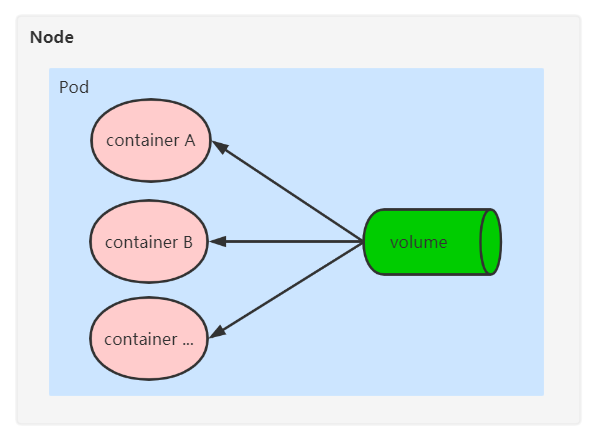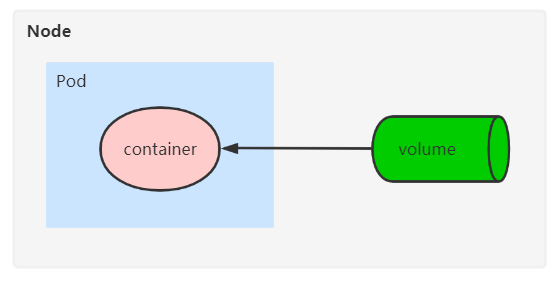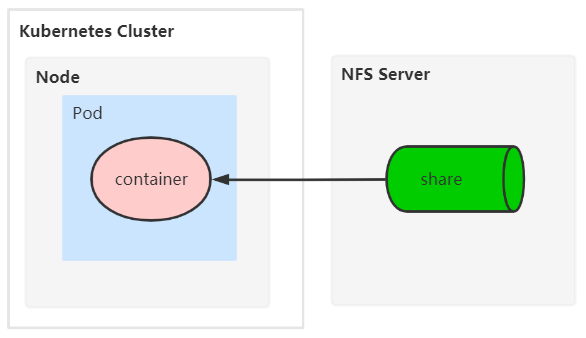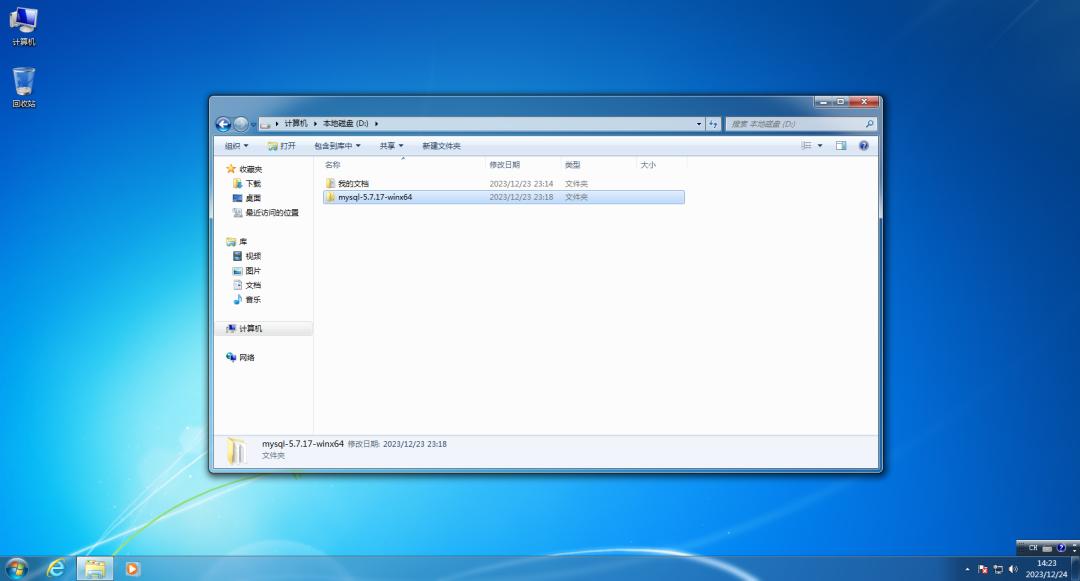和 类似, 中也提供了 来实现数据卷挂载,但 中 是基于 Pod,而不是容器,它可被 Pod 中多个容器共享,另外 中提供比较丰富的 类型[1],如:、、nfs、m、、、 等,每种类型都有其特点及使用场景。
下面将介绍几种常用 类型的使用方式,在这之前先在 .NET Core 服务中添加以下两个接口(镜像版本升级为 1.2.0),以方便后面效果演示。
[HttpGet]
public string GetConfig([FromQuery]string key)
{
// ......
}
[HttpGet]
public string GetVolumeData()
{
// ......
}
:通过传入配置文件 .json 的 key 获取对应值;:获取容器内 /Data/data.txt 的文件内容;
的初始状态是一个没有任何内容的 ,其生命周期与 Pod 一致,当 Pod 中的容器挂掉时, 中的内容不会被清除,容器重启后数据依然可见。只有当整个 Pod 从集群中被删除, 中的内容才会被清除。如下: 位于 Pod 内。

通过以下配置文件创建的 Pod 中将包含 和 两个 , 是一个集成了一些常用 linux 命令的镜像,这里将使用它在 Pod 内进行文件内容修改。 容器的 /app/Data/ 目录文件与 容器的 /data/ 目录文件将通过 进行共享。
apiVersion: apps/v1
kind: Deployment
metadata:
name: emptydir-demo
spec:
replicas: 1
selector:
matchLabels:
name: emptydir-demo
template:
metadata:
labels:
name: emptydir-demo
spec:
containers:
- name: k8sdemo
image: beckjin/k8sdemo:1.2.0
volumeMounts:
- mountPath: /app/Data/
name: share
ports:
- containerPort: 80
- name: busybox
image: busybox
command:
- "/bin/sh"
- "-c"
- "sleep 3600"
volumeMounts:
- mountPath: /data/
name: share
volumes:
- name: share
emptyDir: {}
---
apiVersion: v1
kind: Service
metadata:
name: emptydir-demo-service
spec:
selector:
name: emptydir-demo
type: NodePort
ports:
- port: 80
targetPort: 80

执行命令 exec -it -demo--p6pzz -c -- /bin/sh 进入 容器,然后执行 echo ' ' > /data/data.txt,最后访问 服务的 接口获取文件内容:
类型是挂载宿主机上的文件或目录到 Pod 中,与 Pod 所在的 Node 是强关联的,所以当 Pod 因重启被重新调度时,一定要确保所在主机的相关文件或目录的正确性,如下:

如下配置中 字段设置为 2 ,正常情况下 Pod 将会在 node1 和 node2 上分别被创建rpcbind,另外 字段中的 path 指定了 /data// 目录挂载到容器内的 /app/Data/,所以分别在 node1 和 node2 创建 /data//data.txt ,内容为 node1 和 node2 。
kind: Deployment
metadata:
name: hostpath-demo
spec:
replicas: 2
selector:
matchLabels:
name: hostpath-demo
template:
metadata:
labels:
name: hostpath-demo
spec:
containers:
- name: k8sdemo
image: beckjin/k8sdemo:1.2.0
volumeMounts:
- mountPath: /app/Data/
name: share
ports:
- containerPort: 80
volumes:
- name: share
hostPath:
path: /data/k8sdemo
type: Directory
---
apiVersion: v1
kind: Service
metadata:
name: hostpath-demo-service
spec:
selector:
name: hostpath-demo
type: NodePort
ports:
- port: 81
targetPort: 80
访问 服务的 接口获取文件内容,当路由到不同 Pod(即不同的 node) 返回内容将不一样,如下:
nfs
NFS( file ) 网络文件系统rpcbind,类似 中的文件夹共享。首先在 集群外搭建一个 NFS ,然后指定文件目录进行共享,最终与 Pod 内的容器关联,实现数据卷挂载,如下:

NFS 搭建
在机器上安装依赖组件(集群外的机器 192.168.1.13,并关闭防火墙)
yum install -y nfs-utils rpcbind
将主机上的 /share 目录作为共享目录,如果多个目录可以添加多行
[root@localhost ~]# vim /etc/exports
/share 192.168.1.0/24(insecure,rw,no_root_squash)
启动 NFS
systemctl start rpcbind.service
systemctl enable rpcbind.service
systemctl start nfs.service
systemctl enable nfs.service
集群内各节点安装 nfs-utils,方便使用
yum install -y nfs-utils
完成以上步骤后,在 集群中任意节点执行 -e 192.168.1.13 验证是否正常:
如下配置中 指定了 nfs 字段配置,即将 NFS 中的 /share 目录挂载到容器内的 /app/Data/,与 类型的主要区别是依赖单独的 NFS ,和 node 本身并不耦合。
apiVersion: apps/v1
kind: Deployment
metadata:
name: nfs-demo
spec:
replicas: 2
selector:
matchLabels:
name: nfs-demo
template:
metadata:
labels:
name: nfs-demo
spec:
containers:
- name: k8sdemo
image: beckjin/k8sdemo:1.2.0
volumeMounts:
- mountPath: /app/Data
name: share
ports:
- containerPort: 80
volumes:
- name: share
nfs:
server: 192.168.1.13
path: /share
---
apiVersion: v1
kind: Service
metadata:
name: nfs-demo-service
spec:
selector:
name: nfs-demo
type: NodePort
ports:
- port: 82
targetPort: 80

在 NFS 中执行 echo 'nfs ' > /share/data.txt,然后访问 服务的 接口获取文件内容,如下:
m
m(PVC) 与 (PV) 在使用上是一对密不可分的组合,PV 主要是资源对象定义,PVC 主要是对应资源对象的引用,PV 支持 多种插件类型[2] 进行实现,以下将继续使用 NFS 来作为 PV 插件。
如下图:首先基于 PV 插件在 集群中创建各种资源规格的 PV,根据 Pod 需要存储卷资源创建 PVC, 将符合资源规格要求且消耗资源最小的 PV 绑定到 PVC,PV 和 PVC 是一对一的关系,如果找不到符合条件的 PV,PVC 会一直处于未绑定状态,PVC 绑定成功后可被 Pod 内的容器引用。

NFS 添加 mount 目录
修改 NFS /etc/ 并生效 ,在 集群中任意节点执行 -e 192.168.1.13 验证是否正常:
创建 PV
以下配置将会创建3个 PV, 分别为 500M、1G、2G。
apiVersion: v1
kind: PersistentVolume
metadata:
name: pv-share-a
spec:
nfs:
path: /share_a
server: 192.168.1.13
accessModes:
- ReadWriteMany
capacity:
storage: 500Mi
---
apiVersion: v1
kind: PersistentVolume
metadata:
name: pv-share-b
spec:
nfs:
path: /share_b
server: 192.168.1.13
accessModes:
- ReadWriteMany
capacity:
storage: 1Gi
---
apiVersion: v1
kind: PersistentVolume
metadata:
name: pv-share-c
spec:
nfs:
path: /share_c
server: 192.168.1.13
accessModes:
- ReadWriteMany
capacity:
storage: 2Gi

创建 PVC
apiVersion: v1
kind: PersistentVolumeClaim
metadata:
name: pvc-k8sdemo
spec:
accessModes:
- ReadWriteMany
resources:
requests:
storage: 1Gi

PVC 创建成功后,pv-share-b 的 会变为 Bound,同时 CLAIM 属性会显示相关的 PVC,从上图也可以看出使用的是最小符合资源规格的 PV,并不会将 pv-share-c 绑定到当前 PVC。更多关于 PV 和 PVC 属性说明可参考:-[3]。
创建 Pod
如下配置中 指定了 m 字段配置,这里只需要设置 为前面创建的 PVC 名称 pvc- 即可,使用上比较简单。
apiVersion: apps/v1
kind: Deployment
metadata:
name: pvc-demo
spec:
replicas: 2
selector:
matchLabels:
name: pvc-demo
template:
metadata:
labels:
name: pvc-demo
spec:
containers:
- name: k8sdemo
image: beckjin/k8sdemo:1.2.0
volumeMounts:
- mountPath: /app/Data
name: share
ports:
- containerPort: 80
volumes:
- name: share
persistentVolumeClaim:
claimName: pvc-k8sdemo
---
apiVersion: v1
kind: Service
metadata:
name: pvc-demo-service
spec:
selector:
name: pvc-demo
type: NodePort
ports:
- port: 83
targetPort: 80

在 NFS 中执行 echo 'pvc ' > //data.txt,、 类似,然后访问 服务的 接口获取文件内容,如下:
主要使镜像和配置文件解耦,以便实现镜像的可移植性和可复用性, 是配置信息的集合,可直接注入到 Pod 的容器中使用,扮演着配置中心的角色。 可以以数据卷的形式挂载,也可以基于环境变量的形式注入到 Pod 容器中使用。另外 是一种相对安全的 ,它默认会将配置信息进行 编码,使配置不是明文直接存储在 中,起到一定的保护作用。
下面主要介绍 以数据卷挂载方式的使用,如下图,在 集群中创建一个 资源类型,然后供 Pod 内的容器使用。

如下,创建一个数据卷形式的 ,.json 是 .NET Core 程序内使用的配置文件。
apiVersion: v1
kind: ConfigMap
metadata:
name: configmap-k8sdemo
data:
appsettings.json: |-
{
"ServiceName": "k8sdemo"
}
如下配置中 指定了 资源的名称为以上创建的 对象:-。
apiVersion: apps/v1
kind: Deployment
metadata:
name: configmap-demo
spec:
replicas: 2
selector:
matchLabels:
name: configmap-demo
template:
metadata:
labels:
name: configmap-demo
spec:
containers:
- name: k8sdemo
image: beckjin/k8sdemo:1.2.0
volumeMounts:
- name: configfile
mountPath: /app/appsettings.json
subPath: appsettings.json
ports:
- containerPort: 80
volumes:
- name: configfile
configMap:
name: configmap-k8sdemo
items:
- key: appsettings.json
path: appsettings.json
---
apiVersion: v1
kind: Service
metadata:
name: configmap-demo-service
spec:
selector:
name: configmap-demo
type: NodePort
ports:
- port: 84
targetPort: 80
通过访问 服务的 接口获取指定 key 的值:
参考资料
[1]
类型: #types-of-
[2]
多种插件类型: #types-of--
[3]
-:
限时特惠:本站持续每日更新海量各大内部创业课程,一年会员仅需要98元,全站资源免费下载
点击查看详情
站长微信:Jiucxh




